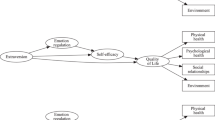Abstract
Drawing upon arguments for the interaction of extraversion and emotional stability in predicting subjective well-being (SWB), we examined the relationship between the extraversion–emotional stability International Personality Item Pool Abridged Big Five Circumplex (AB5C) traits and SWB (NA, PA, and life satisfaction). This AB5C circumplex measures emotional stability and extraversion as well as two positive blends and two negative blends of these traits. Results indicated that the positive blends of extraversion and emotional stability, happiness and poise, were not only correlated with SWB but also explained incremental validity over their Big Five factors. The negative blends of extraversion and emotional stability, talkativeness and impulse control, did not show the same pattern as the positive blends but did display some curvilinear relationships with SWB. While still fitting into the Big Five model, these circumplex traits offer a more nuanced understanding of the relationship between personality and SWB.


Similar content being viewed by others
References
Block, J. (1995). A contrarian view of the five-factor approach to personality description. Psychological Bulletin, 117, 187–215.
Bowling, N. A., Burns, G. N., Stewart, S. M., & Gruys, M. L. (2011). Conscientiousness and agreeableness as moderators of the relationship between neuroticism and counterproductive work behaviors: A constructive replication. International Journal of Selection and Assessment, 19, 320–330.
Burns, G. N., Morris, M. B., & Wright, C. P. (2014). Conceptual and statistical interactions: An illustration with the ABC5 and CWBs. Journal of Business Psychology, 29, 47–60.
Campbell, J. P. (1986). Labs, fields, and straw issues. In E. A. Locke (Ed.), Generalizing from laboratory to field settings (pp. 269–279). Lexington, MA: Lexington Books.
Cohen, J. (1988). Statistical power analysis for the behavior sciences (2nd ed.). Hillsdale, NJ: Lawrence Erlbaum.
Costa, P. T, Jr, & McCrae, R. R. (1980). Influence of extraversion and neuroticism on subjective well-being: Happy and unhappy people. Journal of Personality and Social Psychology, 38, 668–678.
Costa, P. T, Jr, & McCrae, R. R. (1992). Revised NEO personality inventory (NEO PI-R) and NEO five-factor inventory (NEO-FFI): professional manual. Odessa, FL: Psychological Assessment Resources.
DeNeve, K. M., & Cooper, H. (1998). The happy personality: A meta-analysis of 137 personality traits and subjective well-being. Psychological Bulletin, 124, 197–229.
Diener, E. (2000). Subjective well-being: The science of happiness and a proposal for a national index. American Psychologist, 55, 34–43.
Diener, E., Emmons, R. A., Larsen, R. J., & Griffin, S. (1985). The satisfaction with life scale. Journal of Personality Assessment, 49, 71–75.
Eysenck, H. J., & Eysenck, M. W. (1985). Personality and individual differences: A natural science approach. New York: Plenum Press.
Goldberg, L. R., Johnson, J. A., Eber, H. W., Hogan, T., Ashton, M. C., Cloninger, C. R., et al. (2006). The international personality item pool and the future of public-domain personality measures. Journal of Research in Personality, 40, 84–96.
Highhouse, S., & Gillespie, J. Z. (2009). Do samples really matter that much. In C. E. Lance & R. J. Vandenberg (Eds.), Statistical and methodological myths and urban legends: Doctrine, verity and fable in the organizational and social sciences (pp. 249–268). London, UK: Routledge Publishing.
Hofstee, W. K. B., de Raad, B., & Goldberg, L. R. (1992). Integration of the big-five and circumplex approach to trait structure. Journal of Personality and Social Psychology, 63, 146–163.
Hotard, S. R., McFatter, R. M., McWhirter, R. M., & Stegall, M. E. (1989). Interactive effects of extraversion, neuroticism, and social relationships on subjective well-being. Journal of Personality and Social Psychology, 57, 321–331.
Johnson, J. A., & Ostendorf, F. (1993). Clarification of the five factor model with the abridged big five dimensional circumplex. Journal of Personality and Social Psychology, 65, 563–576.
Judge, T. A., & Erez, A. (2007). Interaction and intersection: The constellation of emotional stability and extraversion in predicting performance. Personnel Psychology, 60, 573–596.
Kozma, A., & Stones, M. J. (1980). The measurement of happiness: Development of the Memorial University of Newfoundland Scale of Happiness (MUNSH). Journal of Gerontology, 35, 906–912.
Lynn, M., & Steel, P. (2006). National differences in subjective well-being: The interactive effects of extraversion and neuroticism. Journal of Happiness Studies, 7, 155–165.
McCrae, R. R., & Costa, P. T, Jr. (1991). Adding liebe und arbeit: The full five-factor model and well-being. Personality and Social Psychology Bulletin, 17, 227–232.
McFatter, R. M. (1994). Interactions in predicting mood from extraversion and neuroticism. Journal of Personality and Social Psychology, 66, 570–578.
O’Brien, R. M. (2007). A caution regarding rules of thumb for variance inflation factors. Quality & Quantity, 41, 673–690.
Podsakoff, P. M., MacKenzie, S. M., Lee, J., & Podsakoff, N. P. (2003). Common method variance in behavioral research: A critical review of the literature and recommended remedies. Journal of Applied Psychology, 88, 879–903.
Schimmack, U., Oishi, S., Furr, R. M., & Funder, D. C. (2004). Personality and life satisfaction: A facet-level analysis. Personality and Social Psychology Bulletin, 30, 1062–1075.
Steel, P., Schmidt, J., & Shultz, J. (2008). Refining the relationship between personality and subjective well-being. Psychological Bulletin, 134, 138–161.
Tonidandel, S., LeBreton, J. M., & Johnson, J. W. (2009). Determining the statistical significance of relative weights. Psychological Methods, 14, 387–399.
Watson, D., Clark, L. A., & Tellegen, A. (1988). Development and validation of brief measures of positive and negative affect: The PANAS scales. Journal of Personality and Social Psychology, 54, 1063–1070.
Watson, D., Wiese, D., Vaidya, J., & Tellegen, A. E. (1999). The two general activation systems of affect: Structural findings, evolutionary considerations, psychobiological evidence. Journal of Personality and Social Psychology, 76, 820–838.
Wiggins, J. S., & Pincus, A. L. (1992). Personality: Structure and assessment. Annual Review of Psychology, 43, 473–475.
Author information
Authors and Affiliations
Corresponding author
Rights and permissions
About this article
Cite this article
Morris, M.B., Burns, G.N., Periard, D.A. et al. Extraversion–Emotional Stability Circumplex Traits and Subjective Well-Being. J Happiness Stud 16, 1509–1523 (2015). https://doi.org/10.1007/s10902-014-9573-9
Published:
Issue Date:
DOI: https://doi.org/10.1007/s10902-014-9573-9




